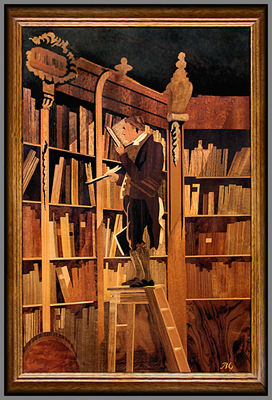|
 |
|
Here we have several more marquetry enquiries that we thought you may find of interest.
The marquetry items displayed on this page mainly consist of pictures that , although they are of very high quality, are not documented in our archives. If you can help us with some information on who created any of these works and any other relevant information regarding their history, would you be so kind as to contact us by clicking the link to the right of the pictures. Thanks for your help. |
December's update see's us with a magnificent amount of further information on the Buchschmid & Gretaux inlay pictures which has been provided courtesy of our very good friend Terry Fout. Terry sent us this superb copy of one of his own Buchschmid & Gretaux pictures entitled "Book Worm". The veneer selection in this picture seems to be very well chosen with some beautifully figured Walnut in evidence. Even a nice quilted effect can be detected from a close study of the library chair's veneer. As well as the Book Worm picture, Terry also unearthed a goodly quantity of Buchschmid & Gretaux's very own descriptive text describing their work methods, veneer selections and product / title list. It is interesting to note that, as well as their pictures, Buchschmid & Gretaux also produced wood inlay work on trays, tables and wall plaques. You will note from reading Buchschmid & Gretaux's description of their working methods that their jig saw style of "wood inlay" produces a sort of "jig-saw puzzle" assembly procedure whereby each jig sawn piece fits correctly into a vacant corresponding slot in the main work piece. |
|
||||
This "jig saw" method differs somewhat to today's Window method whereby the insert veneer in the Window method is cut directly from the utilization of the vacant slot (or window) itself rather than from a remote blueprint drawing. Both methods have their respective merits and it is up to the marquetarian themselves which method they prefer. We rather wonder what Messrs Buchschmid & Gretaux would have made of laser marquetry. It is certainly a process that would have endeared itself to them - it would have saved those tracing paper and blueprint stages, and, it would have ensured almost total accuracy into the bargain. We feel sure it would have appealed to them! The wording in this text on the right is Buchschmid & Gretaux's own description of their working methods. From their description it would seem to be the correct assumption that they were producing their work by the fret or piercing saw methods as we described earlier on page 2 of these enquiries. |
Wood inlay work is a fine art handicraft of medieval origin. It brings into effect the wonderful variety that the thousands of different kinds of wood all over the world show in hues and grains. It is done with veneers, which is the trade term for very thin sheets of wood. These are obtained by slicing up the very best trunks of the desired wood in specialized plants. Burls, knots and roots show the finest and most vivid grain structure. BUCHSCHMID & GRÉTAUX.
|
||||
Some of the veneers mentioned in the Buchschmid & Gretaux "list of veneers" may seem very odd and unusual. As an example, Dosey Walnut is a name that doesn't appear in any of the common veneer lists - another one is Withwood - this is probably a veneer that was locally available to Buchschmid & Gretaux but is not seen outside of their locale. They may also have been "local names" rather than the more familiar generic terminology we are more used to. If we can find the "common names" for those veneers we will bring them to you in another update of these pages. |
LIST OF VENEERS EMPLOYED WITH "BG" INLAY WORK
Titles of Works produced by B & G : Group 1 (largest size) from 24.5” x 17.25” to 20.25” x 12.5” The art of inlay work rests on very few eyes or hands. It will always remain impossible to mass produce. Inlay work is conserved and cleaned like ordinary polished furniture. Do not put them right over your radiator, insulate the pictures by underlaid pieces of cork sheet if your walls are very humid. Try to conserve a minimum amount of air humidity in centrally heated rooms by hanging water containers onto the radiators.
|
||||
Information on the valuation of Wood Inlay or Marquetry pieces Please note that we (The Marquetry Society) are unable to give market reference valuations on any marquetry, or wood inlay works, or pieces of any kind. Quick Links to the other pages in this series: Next set of 'Can We Halp?' Pages from 51 onwards: >>> |
- |
||||
If you are using a different E-mail system to the M/S Outlook Express that our link boxes are utilising and your e-mail client will not open when you click the box, just copy and paste the following address into your "send to" box: info@marquetry.org or, if that is not possible, then just type it in as seen above, thanks |

